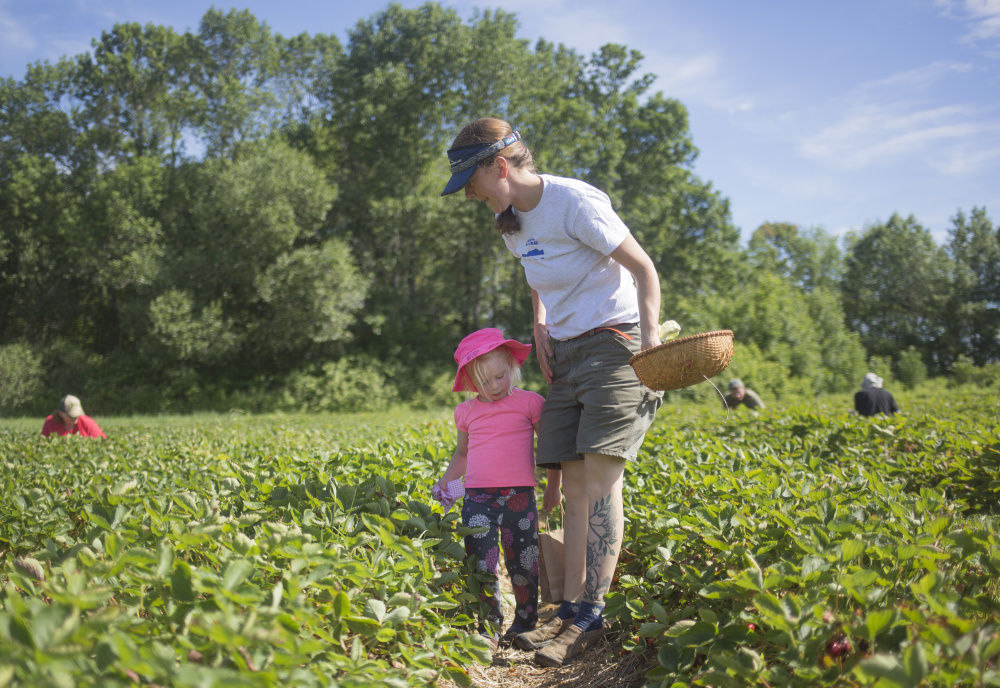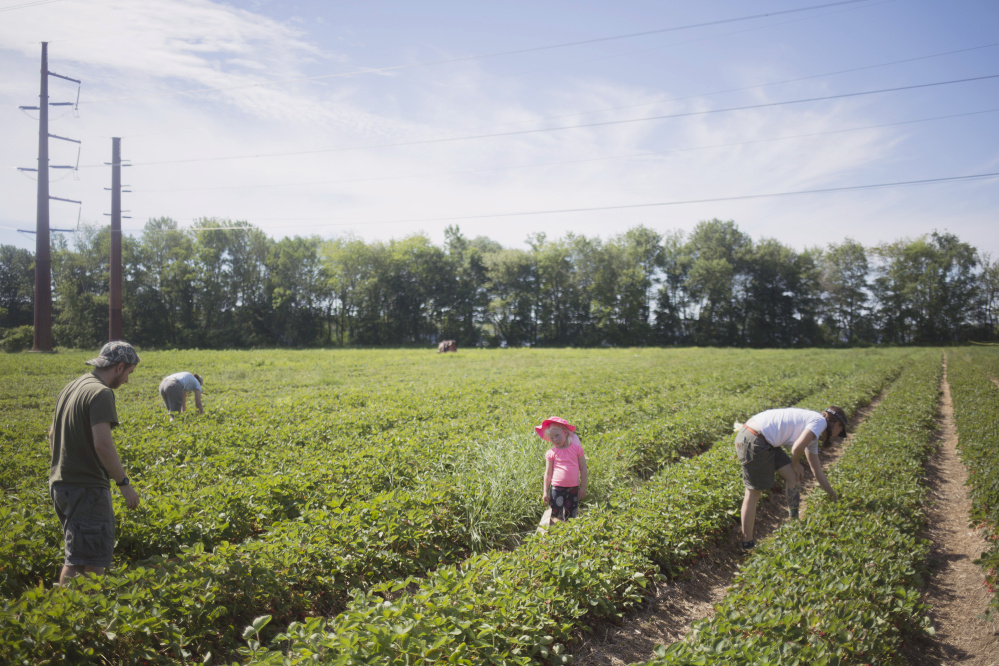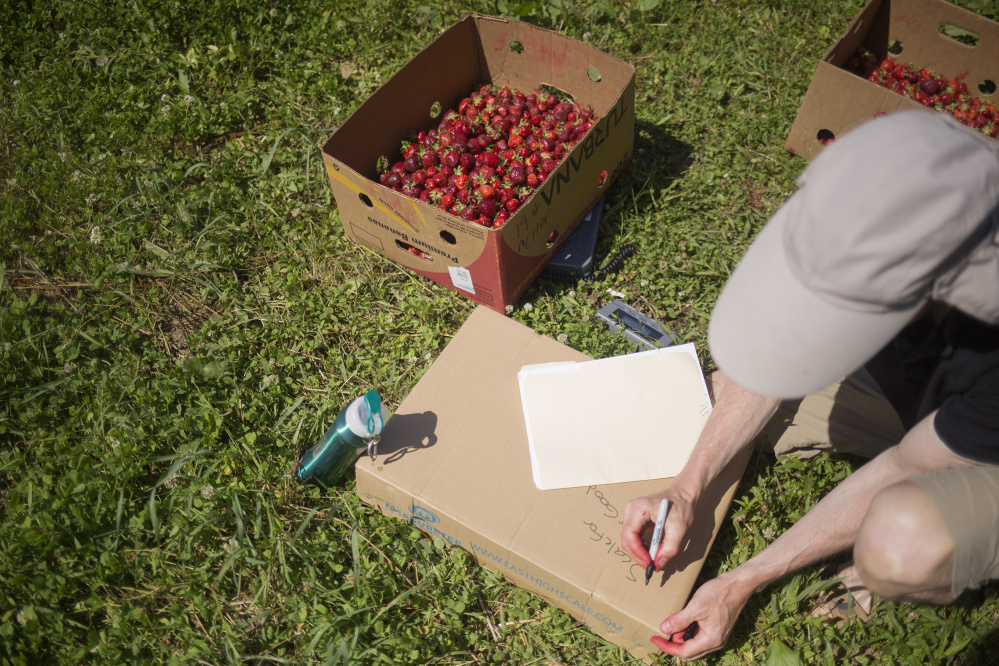One of the hottest summer activities in Maine is volunteering to pick up garbage. Particularly if the garbage can be found on an uninhabited island or some remote stretch of coastline, and really, the more of it the better.
“It is amazing how excited people get about picking up trash,” said Maria Jenness, regional stewardship manager for the Maine Island Trail Association, which by early June already had waiting lists for its beach cleanups. “Of all our volunteer opportunities, the cleanups are the most popular, and they are the most oversubscribed.”
Nonprofits say they’ve seen an increase in volunteerism as Mainers become more concerned about the threats to the state’s treasured areas from factors like climate change and pollution.
“I feel the love,” said Caitlin Gerber, who is the regional steward for Maine Coast Heritage Trust in the Southern Maine region. Whether she’s out on the water or launching her boat at a public boat ramp, she’s getting feedback from the public. “I have a lot of people come up to me and say, ‘I think it is great what you are doing.’ ”
Maine Coast Heritage Trust has 129 preserves around the state. She’s the steward for four islands in Casco Bay, Clapboard, Lane’s, Whaleboat and the Goslings (which is technically a group of very small islands). “I hear that even more in the current political climate.” And more people are stepping up as a result.
But it can be a “bit of a dance and a juggle,” in Jenness’ words, to coordinate that volunteerism. Not only are individuals eager to sign up for visits to islands they’ve never heard of, so are employees from local corporations that require them to do community service work (on the clock). Just about everyone loves to get out of the office, and if it’s to a place like Jewell Island, more the better. “I think the word has gotten out that you can get a boat ride and go out to an island,” Jenness says.
There’s something else about volunteering with a trash bag in hand: The rewards are a lot more obviously tangible than say, stuffing envelopes for a fundraising effort. Last year at Maine’s Coastal Cleanup in September, over a thousand people, many of them school children, collected 19,674 pounds of trash, according to Matthew Nixon of the Department of Agriculture, Conservation & Forestry’s Maine Coastal Program. “That’s after a summer of hard love,” Nixon said. Digging old lighters and plastic soda caps out of crevices in the rocks and picking up abandoned balloons can make a volunteer feel as though they’ve made a real difference,
“Sometimes volunteers are disappointed if they don’t have a boat piled high with garbage,” Jenness said.
BEYOND GARBAGE
Source asked Maine nonprofits and organizations to identify the areas where they could use help from volunteers (see sidebar) and unsurprisingly, the tasks they need help with tend to be those that don’t have that kind of an obvious pay-off. If you monitor water quality for the Friends of Casco Bay, you know you’re contributing to an important data set. It’s a popular program, popular enough that the group is trying to create other positions for all the eager potential volunteers it hears from. “Honestly, sometimes it is hard to keep up with the desire to help,” said Sarah Lyman, who coordinates Friends of Casco Bay’s more than 300 volunteers.
Ditto for gardening and gleaning projects. If you sign up to weed community gardens in Unity weekly for Maine Farmland Trust’s Veggies for All program – which feeds into nine food pantries serving 25 towns – you can see literally see something growing as a result of the hours you’ve put in. (Last year, Veggies for All raised and distributed over 3,600 pounds of food.)

Zach Herbert,a student at Bowdoin College and the summer intern for the Merrymeeting Food Council, gleans strawberries at Fairwinds Farm.
But Maine Farmland Trust would also like to recruit people to serve as ambassadors in their communities. That might mean hosting a “Food for Thought” potluck to brainstorm with others about the future of farming. The land trust – which helps preserve farmland, manages easements and helps new farmers get onto land – had 21 dedicated volunteers last year who put in over 250 hours of service. The ambassador gig “can be a little out of people’s comfort zone,” said Caroline Ginsberg, who coordinates volunteers for Maine Farmland Trust, because it’s more ephemeral.
“It’s not like there is a check box,” Ginsberg said. “What is success?”
“The other day I needed people to make a banner for an event,” she added. “And almost instantly, five people painted this beautiful banner for us.” Those are the easy assignments to fill; hosting a potluck to get your neighbors talking and thinking about food and farming issues might not provide the same quick rush of accomplishment, but it’s needed, Ginsberg said.
Gleaning food that would otherwise go to waste is another one of those chores that gives volunteers an immediate sense of satisfaction. Lee Cataldo, the outreach and education coordinator for the Brunswick-Topsham Land Trust and chair of one of its collaborative programs, the Merrymeeting Food Council, has a regular crew drawn from a list of about 60 that each week sweeps through fields at Six Rivers Farm in Bowdoinham and Goranson Farm in Dresden, gathering excess for area food banks. They also make stops at two farmers markets just as the markets are wrapping up to pick up anything that might otherwise go to waste. Cataldo could certainly use more volunteers for those efforts, but the fact that they’re regularly scheduled makes them easier to coordinate.
It’s the spontaneous calls like the one Cataldo got about strawberries last week that are more complex to find volunteers for. Fairwinds Farm determined a field of berries were undersized and therefore not market worthy and wanted to donate the berries to the Merrymeeting Food Council. Cataldo managed to rally a crew of 10 that picked 300 pounds of berries in just a few hours, but pulling that together on two days notice? Not easy. Not that she’s complaining.
“We are truly blessed as an organization with a pretty small staff,” Catalado said. “The amount of work that we get done in a year is truly a testament to the engagement and willingness of our volunteers.”
“I think gleaning is a much easier sell than other volunteer opportunities,” said Hannah Semler, who coordinates the Maine Gleaning Network. “Because there is a certain excitement. It’s very celebratory, to feel like you’re saving the planet from wasting resources.”

Susan Webbert, a volunteer from Brunswick, helps glean strawberries from a field at Fairwinds Farm. With the harvest looming in the coming weeks, gleaning organizations throughout the state could use more volunteers.
For a lot of volunteers, there has to be an escape factor, Semler said. They want simple, even mindless, tasks that don’t require broader responsibility.
“Volunteers usually want to relax when they are volunteering,” Semler said, “because they are trying to disconnect from their daily life.”
But geography is a factor, Semler said. She signed up 200 volunteers easily for last fall’s Feeding the 5,000 event. In Hancock County, where the gleaning opportunities abound, it’s much more challenging. She had returned from a gleaning event at Four Season Farm in Harborside. One of her volunteers had driven nearly three hours round trip to participate. The fact that Semler was asking for help at “a famous farm” might have been an incentive. (Four Season Farm is owned by farming power couple Eliot Coleman and Barbara Damrosch.)
DEMOGRAPHIC SHIFT
Most groups said they have some volunteers in their 20s and 30s and then, often most reliably, retirees.
“Generally, they’ve retired within the last 10 or 15 years,” Jenness said. The Maine Island Trail Association has about 400 unique volunteers a year – 300 of them participate in the cleanups, she said. Maine Coast Heritage Trust tallies about the same number, Caitlin Gerber said.
“We are making a big effort to get younger people involved,” Gerber said. She likes to use some of the beach cleanup days almost as recruiting tools – often, she says, by June she’s already done a lot of the cleanup herself on the island she stewards. So less trash, more time for outreach.
The group’s “Shorekeepers” are young conservationists who donate $500 or more and tend to help with fundraisers, or, if they have boats, delivering people to islands for cleanups. “These folks have less free time and are more willing to commit to one-off kind of things,” Gerber said.
Problematically, the most devoted volunteers do tend to be retirees, and a lot of them are aging out of the volunteer pool. For whatever reason (possibly, people are retiring later), the ranks of new retirees signing up are smaller. “I have heard this from some other land trusts,” Gerber said. “It’s a very common issue.” And for nonprofits that typically don’t have huge staffs (Maine Coast Heritage Trust is one of the bigger ones, with about 50 on its staff), it’s not always possible to take the time to organize current volunteers or recruit new ones. To counter that problem, Maine Coast Heritage Trust and other Maine groups are working on developing a formal program and streamlining a calendar of events and volunteering opportunities stateside. The Stewardship Network, New England, which is run through the University of New Hampshire’s Cooperative Extension and coordinates a calendar of volunteering and citizen science projects, would provide the template.
“They have a great system,” Gerber said. “You can sign up right on their website and all of that information goes right to that person who organizes the event. It is really useful, especially great for one-day events.”
One thing for sure; any Mainer with an interest in pitching in for sustainability will find organizations waiting with open arms. Even one of the state’s most successful volunteer organizations, Maine Volunteer Lake Monitoring Program, which has 1,300 citizen scientists contributing to its programs and has been in operation since 1971, could use help. Executive director Scott Williams notes that the group has people monitoring 450 Maine lakes for everything from water quality to invasive aquatic plants, which can choke out important native habitat. But, he said, Maine has more than 3,000 lakes and inland bodies of water.
“We have a ways to go before we can say we have all the lakes covered,” Williams said.
Mary Pols can be contacted at 791-6456 or at:
Twitter: MaryPols
Send questions/comments to the editors.







Comments are no longer available on this story